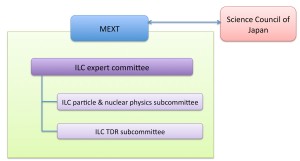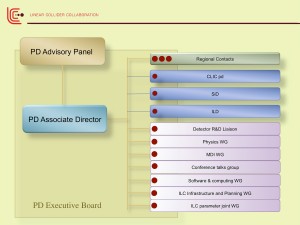
The ILC expert committee established by the Ministry for Education, Culture, Sports, Science and Technology (MEXT) of Japan is divided in two subcomittees.
On 1st May 2014, Japan’s Ministry for Education, Culture, Sports, Science and Technology (MEXT) established an expert committee to investigate various issues raised by the Science Council of Japan regarding the ILC. Then, two subcommittees were created: one, the ILC particle & nuclear physics subcommittee, to investigate the physics case of the ILC, and the other, the ILC TDR subcommittee, to evaluate the soundness of the cost, the human resources and the technical feasibility as described in the ILC Technical Design Report (TDR). The term of committee and subcommittees is set to be until 31 March 2016 even though an extension is possible. The outcome of these committees will bear critical importance when Japanese government decides weather it will officially move to host the ILC. The committees will ask for information from us and other sources as they proceed, and we need to make sure that objective and correct information is provided. In this week’s column, I will mostly focus on efforts from the physics and detector part of Linear Collider Collaboration (LCC).

Organisation chart and working groups (WG) inside the Physics and Detector section of the Linear Collider Collaboration.
First, the ILC infrastructure and planning working group was set up to investigate the time profiles of cost and human resources for the ILC detector efforts, from construction to operation. It will also look into the desirable structure where experimental groups interact with the ILC future laboratory. This working group will give input to the ILC TDR subcommittee looking into cost and human resources even though the scope is limited to detector efforts. Its membership includes quite senior scientists from both ILC detector design (ILD and SiD) groups as well as Japanese physicists familiar with local customs and ways. In order to steer this group of important people, I have recruited Sakue Yamada as chair, who had been leading the physics and detector efforts of the ILC until recently. They have already started to work on this critical task making substantial progress.
For the ILC physics subcommittee, a group of Japanese physicists preparing material and the physics working group of the LCC have been working together intensively. There is a large overlap of membership between the above Japanese groups and the physics working group so that the collaboration has been smooth and productive. The first occasion for input came when an introductory presentation was requested by the subcommittee on the physics case of the ILC. This group of people prepared a set of slides reflecting new results from LHC as well as recent studies. The effort is not finished and will continue to clarify the physics case of the linear collider in view of other proposed facilities such as circular electron-positron colliders.
In the effort above, it became clear that we urgently needed to have an official list of luminosities at different energies of the ILC to be quoted consistently. This is not an easy task, given that there are countless possibilities for the running scenarios. However, we can rely on a group of people who are technically well equipped to deal with this challenge: the ILC parameter joint working group led by Jim Brau and Nick Walker. Here, ‘joint’ refers to both accelerator and physics/detector groups. The final decision should be made at a higher level such as the LCC or the Linear Collider Board (LCB) considering strategic factors. In the presentation I made to the LCB meeting held on 6 July in Valencia, this issue was raised and intensive discussions followed. In the end, such need was officially acknowledged, and the effort by the ILC parameter joint working group immediately accelerated a work which had been started earlier. We will hear soon about its outcome at Linear Collider meetings and workshops.
I have described above our efforts towards the realisation of the ILC. It involves many people, but this effort is just a small fraction of many kinds of fronts being attacked by countless people. We need to convince the Japanese government, but also the other governments. We need to convince our fellow physicists and wider scientist communities in each country, and we need to get support from the general public as well as from the industry. When all these are successful, then finally we will have a real project. We have come a long way already, but we still have a long way to go.


Recent Comments